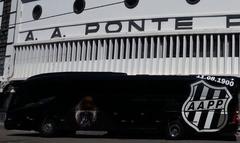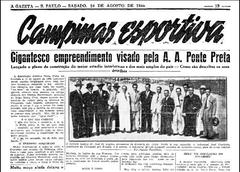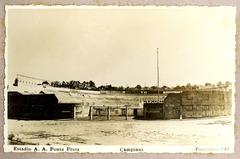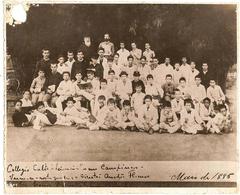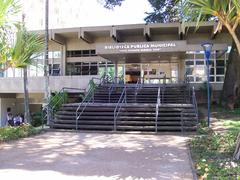
Estádio Moisés Lucarelli: Visiting Hours, Tickets, and Guide to Campinas Historical Sites
Date: 14/06/2025
Introduction
Estádio Moisés Lucarelli, affectionately nicknamed “Majestoso,” is more than a football stadium—it’s a symbol of community pride and one of Campinas, Brazil’s most important cultural and sporting landmarks. As the home of Associação Atlética Ponte Preta, the stadium stands as a testament to grassroots ambition and collective effort, having been built by the hands of local supporters in the mid-20th century. Since its inauguration in 1948, it has played a pivotal role in Campinas’ social and urban landscape. This guide offers detailed visitor information, including opening hours, ticketing, accessibility, and nearby attractions, along with historical context and practical tips for an enriching visit.
For further historical details and visitor advice, consult sources such as Ponte Preta Jubileu de Diamante, StadiumDB, and Hora Campinas.
Historical Overview
Origins and Construction
The idea for Estádio Moisés Lucarelli originated in the late 1930s, when three Ponte Preta supporters—Moysés Lucarelli, Olímpio Dias Porto, and José Cantúsio—launched a fundraising campaign to secure a permanent home for the club. This grassroots “vaquinha” (community collection) led to the purchase of land and the start of construction in 1942. Work was carried out by volunteers and fueled by donations; during weekdays, trucks would collect building materials from local supporters, and on weekends, fans and players alike participated in collective work efforts (pontepreta.com.br; estadios.net).
Inauguration and Early Years
The stadium officially opened on September 12, 1948, during a match between Ponte Preta and XV de Piracicaba. With an initial capacity of 35,000, it was the third-largest stadium in Brazil at the time, a remarkable feat for a city of just 140,000 residents (estadios.net). Its grandeur inspired the nickname “Majestoso,” coined by journalist Fernando Pannattoni (pontepreta.com.br).
Naming and Legacy
Named after Moysés Lucarelli, whose leadership and vision were crucial to its construction, the stadium carries his legacy. A quirk in the registration process led to the spelling “Moisés” with an “i” instead of “y” (estadios.net).
Architectural Features and Capacity
- Style: The stadium’s iconic Art Deco eastern gate, built in the late 1940s, is a registered cultural heritage site in Campinas.
- Capacity: Originally 35,000, the stadium now holds 19,728, with seating adjustments made for safety and accessibility (wikipedia; footballtripper.com).
- Pitch Dimensions: 107 x 70 meters.
- Layout: Classic oval stands, exposed concrete, and simple seating evoke a traditional football atmosphere (StadiumDB).
Role in Brazilian Football
As the home of Ponte Preta, one of Brazil’s oldest football clubs, Estádio Moisés Lucarelli has hosted nearly 2,000 official matches, including storied derbies against Guarani (“Dérbi Campineiro”). The stadium’s record attendance was set in 1978, with over 37,000 spectators (Hora Campinas). Legendary events, such as matches featuring Pelé and international stars like Cristiano Ronaldo, have reinforced its status as a key venue in Brazilian sports history.
Visitor Information
Visiting Hours
- Guided Tours: Typically Monday through Saturday, 9:00 AM to 5:00 PM.
- Match Days: Gates open to ticket holders about two hours before kickoff.
- Note: Always check the official Ponte Preta website for up-to-date schedules, as special events or holidays can affect hours.
Tickets
- Matches: Available online or at the stadium box office; advance purchase is recommended for high-demand matches.
- Guided Tours: Must be booked in advance via official channels (futponte.com.br). Prices are affordable, with discounts for children, seniors, and groups.
Accessibility
- The stadium features ramps and wheelchair-accessible seating, though some areas may remain less accessible due to its historic design. Assistance is available upon request.
Facilities
- Concession stands, restrooms, club shop, and basic amenities are available.
- The main grandstand includes press facilities, VIP areas, and club offices.
Getting There
- Address: Rua Dr. Hércules Florence, 1, Ponte Preta, Campinas, SP, Brazil.
- Public Transport: Multiple bus lines serve the area.
- Parking: Limited, especially on match days; early arrival is advised.
- Taxi/Ride-Sharing: Easily accessible from Campinas city center.
Community & Cultural Impact
Estádio Moisés Lucarelli is a living symbol of Campinas’ collective identity. Built by fan initiative, it remains a hub for community events, educational programs, and social gatherings. The stadium’s nickname—“the stadium built by the fans who have a team”—reflects the deep-rooted connection between Ponte Preta and its supporters (Hora Campinas).
The stadium is also central to the city’s most intense rivalry, the Dérbi Campineiro, which generates an electric atmosphere and unites the city in a shared cultural experience.
Nearby Campinas Historical Sites
When visiting Estádio Moisés Lucarelli, consider exploring these local attractions:
- Museu da Cidade: Offers insights into Campinas’ urban history.
- Metropolitan Cathedral: A striking example of local architecture.
- Bosque dos Jequitibás: A historic urban park nearby.
- Centro de Ciências, Letras e Artes: A cultural hub with museums and galleries.
- Historic Ponte Preta Neighborhood: With charming cafes, bars, and the iconic black bridge.
Frequently Asked Questions (FAQ)
Q: What are the visiting hours?
A: Guided tours are generally available Monday to Saturday from 9:00 AM to 5:00 PM, but always check the official site before your visit.
Q: How do I buy tickets?
A: Purchase online at pontepreta.com.br or at the stadium box office. Early purchase is advised for popular games.
Q: Is the stadium accessible?
A: Yes, with ramps and designated seating, though some historic areas may have limitations.
Q: Are guided tours available?
A: Yes, and they should be booked in advance via the club’s official channels.
Q: What are the best ways to get to the stadium?
A: Public buses, taxis, and ride-sharing are recommended. Parking is limited.
Preservation and Legacy
The stadium’s original architecture, particularly the Art Deco gate and perimeter walls, has been carefully preserved as part of Campinas’ cultural patrimony. Renovations focus on maintaining its historical character while improving safety and accessibility (Minube).
Summary & Call to Action
Estádio Moisés Lucarelli is a must-visit for anyone interested in football heritage, community history, or authentic Brazilian culture. With its unique story, vibrant atmosphere, and proximity to other Campinas attractions, it promises a memorable experience for fans and tourists alike.
Plan your visit:
- Check official visiting hours and events
- Book tickets for matches or tours in advance
- Download the Audiala app for real-time updates and ticket purchases
- Explore more of Campinas’ history by visiting nearby museums and landmarks
For additional resources and up-to-date information, refer to the following sources:
